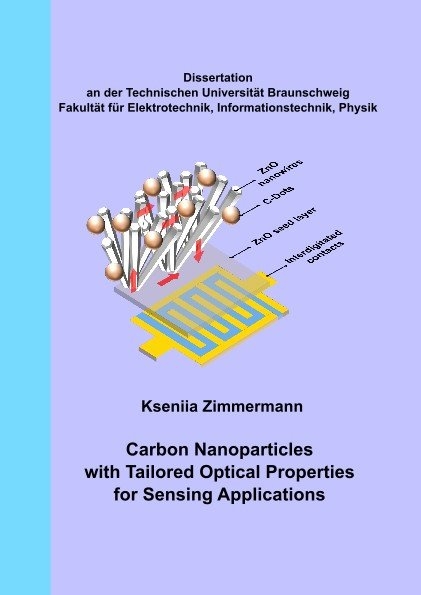
Carbon Nanoparticles with Tailored Optical Properties for Sensing Applications
Seiten
2020
Dr. Hut (Verlag)
978-3-8439-4289-8 (ISBN)
Dr. Hut (Verlag)
978-3-8439-4289-8 (ISBN)
- Keine Verlagsinformationen verfügbar
- Artikel merken
ZnO nanowires (NWs) with their low toxicity, direct wide band-gap and high exciton binding energy have attracted considerable attention for optoelectronic applications. However, their application is limited to the ultraviolet spectral region. To overcome this limitation, the surface functionalisation with semiconductor quantum dots, metal nanoparticles and organic dyes is used. Due to the high acute toxicity of both semiconductor quantum dots and metal nanoparticles, their application is highly limited, while organic dyes show low photostability because of the photocatalytic properties of ZnO NWs. Recently, a new class of carbon materials, known as C-Dots has emerged. Thanks to their low toxicity, photostability, high quantum yield and adjustable optical properties, C-Dots have become substantial alternatives to conventional quantum dots and organic dyes.
The photoresponse of ZnO NW-based devices was shifted towards the visible spectral region via surface functionalisation with specifically prepared C-Dots. The C-Dots were synthesised by a commonly used approach employing citric acid as the carbon source and six different amines: ethylenediamine end-capped polyethylenimine (PEI-EC), diethylenetriamine (DETA), 2,2’-(ethylenedioxy)bis(ethylamine) (EDA), Urea, 2,3-diaminopyridine (2,3-DAP) and 2,3-diaminonaphthalene (2,3-DAN). The optical characterisation of the prepared C-Dots revealed the dependency of their optical properties on the used amines. The strongest absorption red-shifts of 35 nm and 60 nm were observed after PEI-EC was exchanged with 2,3-DAP and 2,3-DAN, respectively.
Three different types of C-Dots (PEI-EC, 2,3-DAP and 2,3-DAN) were selected for the surface functionalisation of ZnO NWs. The ZnO NW devices with PEI-EC-based C-Dots showed an overall enhanced photoresponse in the visible spectral range, while functionalisation with C-Dots containing 2,3-DAP and 2,3-DAN revealed local photoresponse maxima at 2.91 eV and 2.76 eV, respectively.
The photoresponse of ZnO NW-based devices was shifted towards the visible spectral region via surface functionalisation with specifically prepared C-Dots. The C-Dots were synthesised by a commonly used approach employing citric acid as the carbon source and six different amines: ethylenediamine end-capped polyethylenimine (PEI-EC), diethylenetriamine (DETA), 2,2’-(ethylenedioxy)bis(ethylamine) (EDA), Urea, 2,3-diaminopyridine (2,3-DAP) and 2,3-diaminonaphthalene (2,3-DAN). The optical characterisation of the prepared C-Dots revealed the dependency of their optical properties on the used amines. The strongest absorption red-shifts of 35 nm and 60 nm were observed after PEI-EC was exchanged with 2,3-DAP and 2,3-DAN, respectively.
Three different types of C-Dots (PEI-EC, 2,3-DAP and 2,3-DAN) were selected for the surface functionalisation of ZnO NWs. The ZnO NW devices with PEI-EC-based C-Dots showed an overall enhanced photoresponse in the visible spectral range, while functionalisation with C-Dots containing 2,3-DAP and 2,3-DAN revealed local photoresponse maxima at 2.91 eV and 2.76 eV, respectively.
| Erscheinungsdatum | 21.01.2020 |
|---|---|
| Reihe/Serie | Elektrotechnik |
| Verlagsort | München |
| Sprache | englisch |
| Maße | 148 x 210 mm |
| Gewicht | 344 g |
| Themenwelt | Technik ► Elektrotechnik / Energietechnik |
| Schlagworte | C-Dots • sensing • ZnO Nanowires |
| ISBN-10 | 3-8439-4289-7 / 3843942897 |
| ISBN-13 | 978-3-8439-4289-8 / 9783843942898 |
| Zustand | Neuware |
| Haben Sie eine Frage zum Produkt? |
Mehr entdecken
aus dem Bereich
aus dem Bereich
DIN-Normen und Technische Regeln für die Elektroinstallation
Buch | Softcover (2023)
Beuth (Verlag)
86,00 €
Kolbenmaschinen - Strömungsmaschinen - Kraftwerke
Buch | Hardcover (2023)
Hanser (Verlag)
49,99 €


